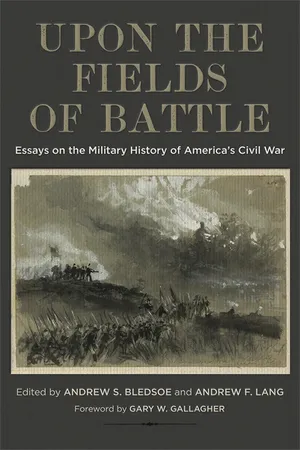![]()
II
THE CONTESTED
BATTLEFIELD
![]()
“I AM COMPLETELY CHECKED BY THE WEATHER”
George B. McClellan, Weather, and the Peninsula Campaign
Kenneth W. Noe
WHEN FUTURE GENERATIONS look back on the Civil War’s sesquicentennial, the defining factor may seem to be that it occurred at the dawn of a digital age. For every scholar who expressed concerned about an apparent lack of popular interest vis-à-vis the centennial of the 1960s, there were dozens of Facebook postings, YouTube videos, blog entries, and live-tweeted reenactments. Future Civil War historians of the bicentennial might well ask, however, whether all of that new media advanced fresh approaches or simply regurgitated accepted wisdom. The coverage of Maj. Gen. George B. McClellan raises a red flag in this regard. Nuanced and often revisionist recent works such as Ethan Rafuse’s 2005 biography, Donald Stoker’s favorable reassessment of McClellan’s strategic vision, and Glenn David Brasher’s evaluation of slavery and the Peninsula Campaign seemingly did little to stem the popular tide of McClellan bashing. The general’s digital presence during the sesquicentennial more typically involved popular cut-and-pasted web articles such as “Commanders in Chaos: The 5 Worst Generals in U.S. History,” in which the author concluded, “had Lincoln retained McClellan in command of the Union armies, many former Americans might still be whistling ‘Dixie.’”1 Not to be outdone, another author ranked McClellan seventh among the “Top 10 Worst Military Leaders in History,” just between Robert Nivelle and Saddam Hussein.2 On the popular webzine Slate, John Swansburg entitled his article on McClellan, “The Civil War’s Most Chicken General.”3 In making these arguments, modern e-authors simply added hyperbole and repeated the judgments of previous generations of print historians who repeatedly damned McClellan as slow, timid, and petulant.4
Not surprisingly, the Peninsula Campaign figures prominently in the timidity/petulance trope. Popular authors can draw upon significant historians who paint a picture of an overly elaborate operational plan and a grand turning movement through the Chesapeake Bay that Abraham Lincoln wisely disdained. McClellan’s lack of aggressiveness against outnumbered Confederates, whose inflated numbers “Little Mac” foolishly accepted, further undermined the march to Richmond. At Yorktown, according to James M. McPherson, his “only action was to inch forward with his siege while [Confederate general Joseph] Johnston brought 40,000 more men to the peninsula.” At least the historians acknowledge another factor. Once Johnston retreated, McPherson continues, “further Union pursuit bogged down in heavy rains that turned the roads into a morass. The rains persisted for nearly a month, during which there was much sickness, much corduroying . . . of bottomless roads, much building of bridges over swollen creeks, and much cursing—but little fighting.” McClellan’s muddy men crawled to the outskirts of Richmond, where Robert E. Lee took command after Johnston was wounded and broke the Union commander’s will to fight in a week of hard combat. McClellan was “a beaten general” whose only response was to blame the White House.5
This chapter seeks to move beyond the hoary “good general–worst general” straightjacket in order to better assess the factor that scholarly critics admit contributed to McClellan’s defeat—the weather. Usually described as “rainy” or “bad,” precipitation on the Peninsula during the campaign in fact was unusually torrential that spring, and it played more of a role in delaying the army than McClellan’s personality. The causes of that heavy and persistent rain remain elusive, but over the last few years, many meteorologists with a historical bent have speculated that El Niño–Southern Oscillation (ENSO) might have been involved at some level. Hundreds of miles off the western coast of South America, subsurface waters sometimes heat up or cool down a few degrees for reasons that still defy easy explanation. Ocean currents and winds churn those waters to the surface, where contact with eastward-blowing trade winds occurs. Growing stronger, west winds transport the warmer or cooler air toward land. Warmer temperatures bring the El Niño phenomenon, while cooler air leads to the opposite La Niña effect. Both involve dramatically shifting weather patterns worldwide. Scientists first hypothesized the existence of ENSO in the late 1870s as an explanation for the devastating monsoon of 1876 in India. They could only begin to prove its existence in the late 1960s, however. Meteorologists more recently have read backward into the records from the later decades of the nineteenth century in order to identify ENSO’s earlier handiwork. Lacking full data from modern tools, any conclusions remain tentative and debatable. Meteorologists have considered both El Niño and La Niña, while other recent work leans toward the North Atlantic Oscillation as a more critical factor in the early 1860s, perhaps in conjunction with a mild El Niño. Whatever the final verdict, the Peninsula Campaign ultimately serves as a useful example of how considerations of climate, weather, and soil can help better explain the experience and conduct of the Civil War, as opposed to “good/bad general.”6
Unusual and intense weather dramatically influenced the Civil War everywhere during its first winter. In Virginia December was remarkably warm, but the new year brought heavy rain and acres of mud to the Potomac. All across the embattled Confederacy that ...



